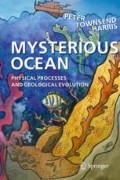Abstract
How deep is the ocean? To find the answer to this question is not as simple as you may think. Ocean mapping technology has developed over time, and there have been many advances like the invention of sonar. But it is a fact that Mars is better mapped than of our own ocean floor. The search for the missing Malaysian Airline Flight MH370 in the Indian Ocean illustrates how poorly our oceans are mapped. In this chapter we will learn how to take a piston core sample of the ocean floor, and we will meet Maurice (Doc) Ewing and learn how he invented seismic profiling so that we could “see” the layers of rocks and sediment beneath the ocean floor. But all of our sonars and seismic systems make a lot of noise. How has this impacted on marine mammals and other ocean creatures?
“This new (sonar) method has in a few years completely altered our concept of the topography of the ocean bottom. Basins and ridges, troughs and peaks have been discovered, and in many areas a bottom topography has been found as rugged as the topography of any mountain landscape. ”
Harald Sverdrup, Martin Johnson, and Richard Fleming
The Oceans, 1942
Access this chapter
Tax calculation will be finalised at checkout
Purchases are for personal use only
Notes
- 1.
“Dead reckoning” is a term sailors use to describe the process of using the ship’s speed and course to estimate its present position by extrapolating backward to the ship’s last known position. This works fine if there is no current or wind shear blowing you off course (except there is nearly always some current and wind shear!).
- 2.
- 3.
Becker et al. (2009).
- 4.
Picard et al. (2018).
- 5.
Smith and Sandwell (1997).
- 6.
Schlee (1978).
- 7.
Harris et al. (2016).
- 8.
Williams et al. (2015).
- 9.
Kvenvolden and Cooper (2003).
References
Becker, J. J., Sandwell, D. T., Smith, W. H. F., Braud, J., Binder, B., Depner, J., Fabre, D., Factor, J., Ingalls, S., Kim, S. H., Ladner, R., Marks, K., Nelson, S., Pharaoh, A., Trimmer, R., Von Rosenberg, J., Wallace, G., & Weatherall, P. (2009). Global bathymetry and elevation data at 30 arc seconds resolution: SRTM30_PLUS. Marine Geodesy, 32(4), 355–371.
Harris, P. T., Alo, B., Bera, A., Bradshaw, M., Coakley, B. J., Grosvik, B. E., Lourenço, N., Moreno, J. R., Shrimpton, M., Simcock, A., & Singh, A. (2016). Chapter 21. Offshore hydrocarbon industries. In L. Inniss, A. Simcock, A. Y. Ajawin, et al. (Eds.), United Nations World Ocean assessment. Cambridge: Cambridge University Press.
Kvenvolden, K. A., & Cooper, C. K. (2003). Natural seepage of crude oil into the marine environment. Geo-Marine Letters, 23, 140–146.
Picard, K., Brooke, B. P., Harris, P. T., Siwabessy, P. J. W., Coffin, M. F., Tran, M., Spinoccia, M., Weales, J., Macmillan-Lawler, M., & Sullivan, J. (2018). Malaysia airlines flight MH370 search data reveal geomorphology and seafloor processes in the remote Southeast Indian Ocean. Marine Geology, 395(Supplement C), 301–319.
Schlee, S. (1978). On almost any wind. London: Cornell University Press.
Smith, W. H., & Sandwell, D. T. (1997). Global sea floor topography from satellite altimetry and ship depth soundings. Science Magazine, 277(5334), 1956–1962.
Sverdrup, H. U., Johnson, N. W., & Flemming, R. H. (1942). The oceans (p. 1087). Prentice Hall: Englewood Cliffs.
Williams, R., Wright, A. J., Ashe, E., Blight, L. K., Bruintjes, R., Canessa, R., Clark, C. W., Cullis-Suzuki, S., Dakin, D. T., Erbe, C., Hammond, P. S., Merchant, N. D., O’Hara, P. D., Purser, J., Radford, A. N., Simpson, S. D., Thomas, L., & Wale, M. A. (2015). Impacts of anthropogenic noise on marine life: Publication patterns, new discoveries, and future directions in research and management. Ocean & Coastal Management, 115(Supplement C), 17–24.
Author information
Authors and Affiliations
Rights and permissions
Copyright information
© 2020 Springer Nature Switzerland AG
About this chapter
Cite this chapter
Harris, P.T. (2020). How Deep Is the Ocean?. In: Mysterious Ocean. Springer, Cham. https://doi.org/10.1007/978-3-030-15632-9_4
Download citation
DOI: https://doi.org/10.1007/978-3-030-15632-9_4
Published:
Publisher Name: Springer, Cham
Print ISBN: 978-3-030-15631-2
Online ISBN: 978-3-030-15632-9
eBook Packages: Earth and Environmental ScienceEarth and Environmental Science (R0)

